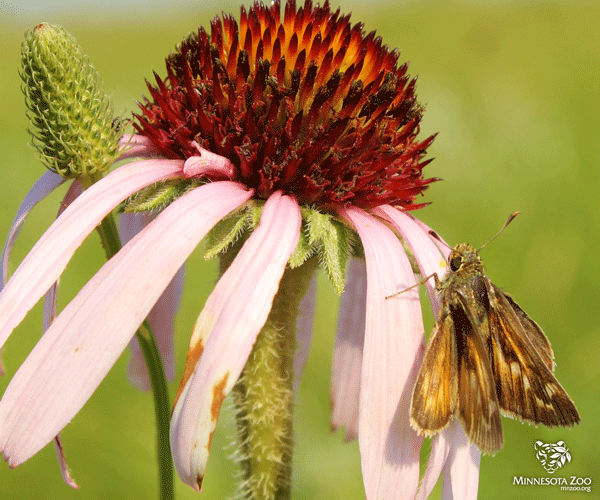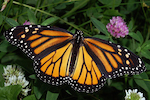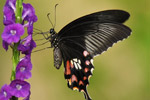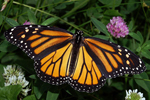
First female Dakota skipper reared at the Minnesota Zoo. Photo by: Erik Runquist/Minnesota Zoo.
This fall, the U.S. Fish and Wildlife Service added two little-known prairie butterflies to the Endangered Species Act. One of the species, the Poweshiek skipperling (Oarisma poweshiek), may be down to only a few hundred individuals. The Dakota skipperling (Hesperia dacotae) is faring a little better, but both have lost the majority of their habitat in the past few hundred years and continue to decline.
“Both [butterflies] have experienced significant regional and global declines in the last few decades, and they certainly must rank among the most endangered species on earth, especially the Poweshiek skipperling,” Erik Runquist with the Minnesota Zoo told mongabay.com. Runquist, who works with the zoo’s Prairie Butterfly Conservation Program, has been attempting to breed the species in captivity.
The listing under the ESA, the U.S.’s most powerful form of protection for vanishing species, should help preserve remaining habitat for the two species. However, Runquist says the most powerful outcome of the decision may actually be publicity.
“Charismatic megafauna usually grab the headlines, but we know next to nothing about most of the little creatures that are vital to ecosystem functions. Butterflies are better appreciated and known than most insects, but very few people know of Poweshiek skipperlings and Dakota skippers or of their stories,” he explained. “Their recent disappearance from much of their already highly fragmented range, as well as the apparent coincident decline of many other prairie butterfly species, is a real cause for concern. It suggests that the ecologically and historically vital prairies of the Upper Midwest are facing real, often unknown, threats. These two butterflies are just the most dramatic examples, and it is reasonable to assume that many others are experiencing the same difficulties.”
The North American tallgrass prairie, where these species reside, is one of the most imperiled ecosystems in the world. Less than one percent of the historic prairie survives today as over the centuries most has been converted to agriculture.
Runquist said that while it’s important to protect these species for their ecological role—including pollination—there are other, less tactile reasons, as well for saving these species from oblivion.
“The world would be a smaller, lonelier place for humanity if these small butterflies go extinct,” he noted.
For more on the plight of the Poweshiek skipperling: Zoo races to save extreme butterfly from extinction.

Wild Dakota skipper. Photo by: Erik Runquist/Minnesota Zoo.
Related articles
‘Canary in the cornfield’: monarch butterfly may get threatened species status

(09/08/2014) Monarch butterflies were once a common sight throughout the North American heartland. But declines in milkweed – their caterpillars’ only source of food – have led to a 90 percent decline in monarch numbers. Now, the U.S. Fish and Wildlife Service is reviewing a petition that would grant the iconic species protection through the Endangered Species Act.
|
U.S. citizens willing to spend billions to protect monarch butterflies
(04/03/2014) New research shows Americans are willing to pay for the protection of the ailing monarch butterfly, which is experiencing a steep decline in numbers. The study, published in Conservation Letters, found nearly three-quarters of those surveyed placed importance on conservation efforts for the iconic species. |
|
Scientists discover single gene that enables multiple morphs in a butterfly
(03/10/2014) Scientists have discovered the gene enabling multiple female morphs that give the Common Mormon butterfly its very tongue-in-cheek name. doublesex, the gene that controls gender in insects, is also a mimicry supergene that determines diverse wing patterns in this butterfly, according to a recent study published in Nature. The study also shows that the supergene is not a cluster of closely-linked genes as postulated for nearly half a century, but a single gene controlling all the variations exhibited by the butterfly’s wings. |
|
Migrating monarch butterflies hit shockingly low numbers
(01/31/2014) The monarch butterfly population overwintering in Mexico this year has hit its lowest numbers ever, according to WWF-Mexico. Monarch butterflies covered just 0.67 hectares in Mexico’s forest, a drop of 44 percent from 2012 already perilously low population. To put this in perspective the average monarch coverage from 1994-2014 was 6.39 or nearly ten times this year’s. For years conservationists feared that deforestation in Mexico would spell the end of the monarch migration, but now scientists say that agricultural and policy changes in the U.S. and Canada—including GMO crops and habitat loss—is strangling off one of the world’s great migrations. |
|
you're currently offline |

















